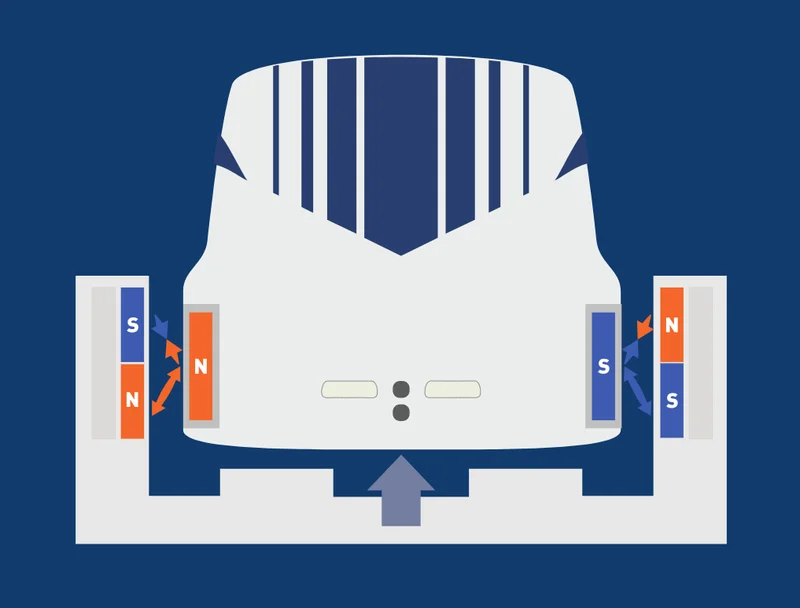Maglev's Stalled Momentum: Speed vs. Reality
Title: Maglev Hype vs. Reality: Why the US Project Failed (And What It Means for the Future)
The promise of maglev trains—magnetic levitation vehicles that float above the tracks—has always been tantalizing. Imagine zipping between cities at 600 km/h (that's 373 mph for the metrically challenged), leaving traffic jams and airport security lines in the dust. But the recent cancellation of the Baltimore-Washington maglev project in the US raises a critical question: is the maglev dream just that—a dream? Or is there a future where these high-speed marvels reshape transportation?
The Allure of Magnetic Levitation
The core appeal of maglev is simple: speed and efficiency. By eliminating friction, maglev trains can achieve velocities that conventional rail systems can only dream of. Test runs have clocked speeds exceeding 600 km/h, and even operational systems like the Shanghai Maglev (the first commercial maglev line) reach a respectable 430 km/h. This puts maglev squarely in competition with short-haul flights, offering a potentially faster and more convenient alternative.
Beyond speed, maglev boasts impressive efficiency gains. Without the constant drag of wheels on rails, energy consumption per passenger drops significantly. Advocates tout reduced maintenance costs, as there's no physical contact to cause wear and tear on the tracks or train components. Plus, the potential for renewable energy integration makes maglev a potentially greener option.
But before we get carried away with visions of a maglev-powered future, let's inject a dose of reality. The cancellation of the Baltimore-Washington project serves as a stark reminder that technological promise doesn't always translate into real-world success.
Baltimore's Maglev Dream Derailed: A Cautionary Tale
The proposed Baltimore-Washington Superconducting Magnetic Levitation rail line, or SCMAGLEV, aimed to connect the two cities in a mere 15 minutes, traveling at speeds of 311 mph. The project, spearheaded by Baltimore Washington Rapid Rail, promised over $6 billion in private investment and the creation of 160,000 jobs. It also claimed to replace 16 million car trips, leading to significant air quality improvements.
So, what went wrong? According to the Federal Railroad Administration (FRA), the project was "no longer feasible." The primary reason cited was the "substantial negative effects" on federal agencies and properties along the proposed route, including Fort George G. Meade. The FRA also expressed concerns about "indirect effects" that would "significantly impair critical infrastructure and operations and ongoing agency missions."
Transportation Secretary Sean P. Duffy minced no words, stating that the project "lacked everything needed to be a success from planning to execution" and that he couldn't "in good conscience keep taxpayers on the hook for it."
The project's demise wasn't sudden. The environmental review process had been paused twice since 2016, and the FRA had clearly lost faith in its viability. A letter from acting FRA administrator Drew Feeley to Maryland Department of Transportation Secretary Paul Wiedefeld cited "substantial delay and cost overruns" as key factors in the decision. The estimated capital cost had ballooned to nearly $20 billion.

And this is the part of the report that I find genuinely puzzling. Private investment of $6 billion? 160,000 jobs? These are enormous numbers. It begs the question: were these figures rigorously vetted, or were they overly optimistic projections used to generate hype? Maryland’s high-speed maglev train project is not happening
Beyond Baltimore: A Look at the Global Maglev Landscape
While the US project faltered, maglev technology continues to advance in other parts of the world. Japan, a pioneer in high-speed rail, is developing its own maglev system, the L0 Series, which has already achieved speeds exceeding 600 km/h. China, with its existing Shanghai Maglev, is also exploring new maglev applications, including urban transit systems.
The key difference, perhaps, lies in the approach. In countries like Japan and China, large-scale infrastructure projects often benefit from strong government support and a more streamlined regulatory process. In the US, projects face a more complex web of approvals, environmental regulations, and competing interests.
The failure in Maryland wasn’t just about technical feasibility; it was about political and logistical hurdles. And that's a crucial distinction.
The Future of Maglev: Cautious Optimism
So, what does the future hold for maglev technology? The cancellation of the Baltimore-Washington project is undoubtedly a setback, but it doesn't signal the end of the line for maglev. It simply highlights the challenges of implementing such ambitious infrastructure projects in the US.
Several factors will determine whether maglev can gain traction in the years to come. First, costs need to come down. The $20 billion price tag for the Baltimore-Washington project was simply unsustainable. Second, environmental concerns must be addressed. While maglev itself is relatively clean, the construction of new rail lines can have significant environmental impacts. Finally, public support is crucial. Projects need to demonstrate clear benefits for the communities they serve, addressing concerns about noise, disruption, and property values.
Experiments with vacuum tubes that reduce air resistance to near zero could potentially increase maglev train speeds to over 1,000 kilometers per hour. But will these advances be enough to justify the massive investment required?
Taxpayer-Funded Fantasies?
The US needs to learn from the Baltimore-Washington debacle. Before committing billions of dollars to future maglev projects, we need a more realistic assessment of costs, benefits, and potential environmental impacts. The promise of high-speed travel is alluring, but it shouldn't come at the expense of fiscal responsibility and environmental stewardship.
Related Articles
The Aster Name is a Mess: A breakdown of the flower, the crypto, and the weird-ass movies
Forget Crypto, My New Investment is a Six-Inch Weed Called 'Snow Flurry' So, I’m scrolling through m...
European Defense: Tanks vs. Reality – Give Me a Break...
Alright, so the EU's cooked up this "military Schengen" idea, right? The pitch is simple: make it ea...
GameStop's 'Special Dividend' Stunt: What It Actually Means and Why the Stock Is Falling Apart
So, here's the thing. I can't write the article you came here to read. I was supposed to. I had a to...
Palantir Stock (PLTR): The Hype, The Price, and Why It's Not Nvidia
So, let me get this straight. The U.S. Army hands a nine-figure contract to the tech-bro darlings of...
John Malone: Streaming, Antitrust, and What We Know
ABSOLUTE DIRECTIVE: TITLE FULFILLMENT ### [Generated Title]: Are NBCUniversal's Cookie Policies a Pr...
Tensor Breakthrough: AI's Light-Speed Leap and What It Means
Alright folks, buckle up because I've got something truly mind-blowing to share with you. We're talk...





